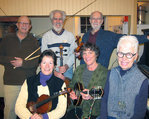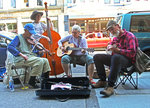Folk music is alive and well in Port Townsend, and old-time dance events regularly bring hordes of toe-tappers who like to do-si-do, allemande and swing their partners.
Quimper Grange hosts a …
This item is available in full to subscribers.
We have recently launched a new and improved website. To continue reading, you will need to either log into your subscriber account, or purchase a new subscription.
If you had an active account on our previous website, then you have an account here. Simply reset your password to regain access to your account.
If you did not have an account on our previous website, but are a current print subscriber, click here to set up your website account.
Otherwise, click here to view your options for subscribing.
* Having trouble? Call our circulation department at 360-385-2900, or email our support.
Please log in to continue |
|


Folk music is alive and well in Port Townsend, and old-time dance events regularly bring hordes of toe-tappers who like to do-si-do, allemande and swing their partners.
Quimper Grange hosts a second-Saturday square dance and third-Saturday contra dance each month. The two kinds of dances are quite similar, from the fiddle-heavy music to the fact that both dances require a “caller,” who tells the dancers what to do (square dancing) or reminds the dancers what’s coming next (contra).
Contra dancers stand in lines opposite partners, and there’s no minimum number of couples needed. Square dancers stand in a square formation of eight people; four couples are needed. But they do a lot of the same moves, including the allemande, do-si-do and swing.
In fact, square and contra dance cultures have only recently separated; it used to be that the two styles would alternate at the same dance – and that was the case at the Grange’s New Year’s Eve dance. Jo Yount called contras, and Dave Thielk called squares. Until about three years ago, Quimper Grange community dances also featured both styles.
“When we started dancing in the ’80s, you went to a dance and you did some of each,” said Yount, who calls contra dances in Port Townsend. “And nobody ever thought about them as being separate.” Nowadays, she said, “some people get upset because they only want to do one or the other.”
Thielk said the separation “started back east.” He cited Phil Jamison, who writes about old-time music and dance. Jamison wrote some articles in the ’80s that lament dancers’ impatience with square dance.
“Contras require a more restrained and controlled music than squares – more regularly phrased, like marching music,” Jamison wrote. He also wrote that contra music tends to be “cleaner, friendlier and more palatable to yuppie ears than the less tame Southern old-time string band sound.”
Jamison’s description of contra dancing makes it sound like “speed dating,” in which one dances with many more people in one dance; square dance requires a bit more patience and involves a closer connection with one’s immediate “square.”
Thielk, a local teacher, calls squares and is instrumental in the Port Townsend square dancing community.
DIFFERENT CULTURE
Contras “attracted a different culture” of dancers, Thielk said. For one thing, “contra dancers are fussier about mistakes. Some don’t want to dance with beginners,” he said. Of course, beginners are heartily welcomed at contra dances, but might find square dancing a bit more amenable. There’s “much less instruction” from a contra caller, whereas a square-dance caller teaches each dance and generally talks more.
“It’s much harder to call squares, and the band plays a different role,” Thielk said. In traditional contra dances, “the band really did move the dancers” and callers gives “clues.” Square dance callers keep up a chatty patter. Yount said she and other callers go through the dance moves before each dance so participants know what to do.
“Many of the same people go to both dances,” Yount said. “They have no problem finding musicians,”" she added. “There are so many bands in Port Townsend,” she said. “So many people who want to play.”
A three-person band is sufficient for a contra dance. “I can’t imagine a band without a fiddle playing at a contra dance,” she said. There’s usually a guitar, sometimes percussion. “There’ll be a mandolin … it varies. Sometimes a concertina,” she said. Musicians and bands are flexible; on New Year’s Eve, Carol Hardy played guitar in both bands at the Grange.
The PT Cruisers, playing on Jan. 17, have also played for English country dances in PT for the last five years. The band offers twin fiddling by Libby Schnick and Dan Post, Marsha Wiener on piano, Libby Reid on mandolin and guitar, Ken Thompson on drums, and Fred Nussbaum on cello and mandolin.
Yount said, “What I like about contra is, so long as you have a partner, you can dance. Squares require eight. As soon as you have six, you can’t [dance].”
Thielk said contra might be seen more as a “kinesthetic meditation” done with other people, in that it’s structured and repetitive. Square dancing, in contrast, “is more like a commitment to a community. Less sophisticated people have been drawn to squares,” he added, explaining that contra dancers tend to be more educated and less “blue collar” at square dances back east and in big cities. “But in smaller communities and in Port Townsend, that generalization isn’t necessarily so true.” He noticed that while contra dancers are smiling and having a great time, “square dancers tend to be laughing.”
Yount noted that in contra dances, “you switch the people you’re dancing with. You have fresh faces,” unlike in squares, where you dance with the same eight people for the whole tune.
Some people prefer contra dancing so vehemently that they won’t even join in a square. Others complain that square dances can degenerate into dancers just shaking their sillies out, swinging their partners willy-nilly or otherwise “stepping out of line.”
DARE TO BE SQUARE
There is a resurgence of interest in square dancing among younger folks, particularly noticeable in the Chimacum farming community.
“The movement to bring square dancing back to the front is happening all up and down the West Coast with ‘Dare to Be Square’ gatherings every year,” Thielk said.
In Port Townsend, Joanne Pontrello, who is in her 20s, has been calling square dances at the Grange and elsewhere.
“Many of the callers I have engaged to call our square dances have told me that we have one of the best community square dances in the country,” Thielk said.
Although the dances take place on different nights and cater to different tastes, there are no hard feelings; both Yount and Thielk said they like dances that include both contra and square dance. Both also said that a lot of dancers often go to both events.
Yount is the caller at this Saturday’s contra dance, 7:30-10:30 p.m., Jan. 17, at Quimper Grange, 1219 Corona St. Admission is $6 for adults, $3 for ages 3-18 and free for those younger than 3.
Featured at the next square dance, on Feb. 8, is an especially good caller, T Claw, who calls square dances all over the country. At Feb. 14’s square dance, Thielk is caller, and tunes are by Airstream Traveler.
For more information, visit ptcommunitydance.blogspot.com or quimpergrange.com.